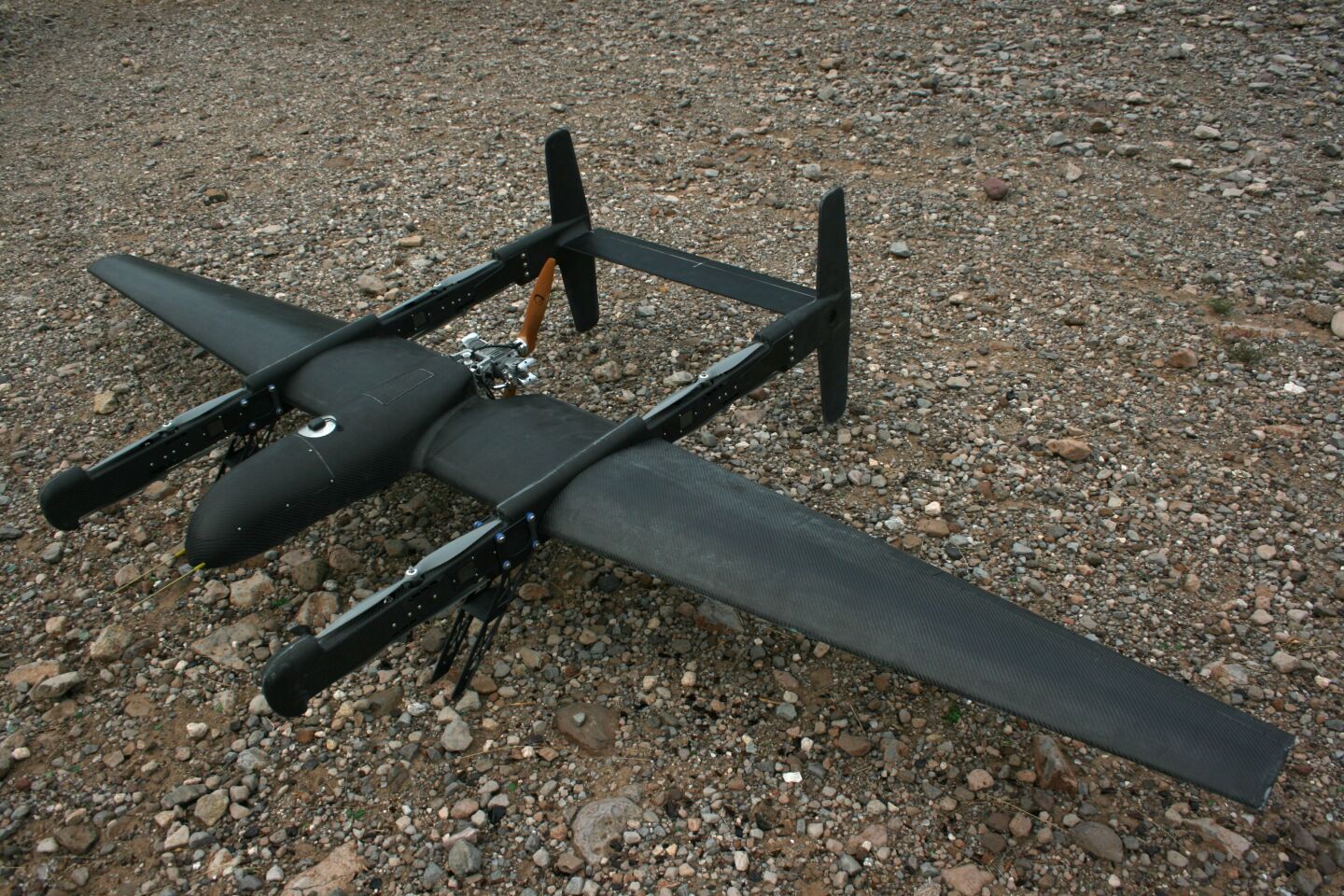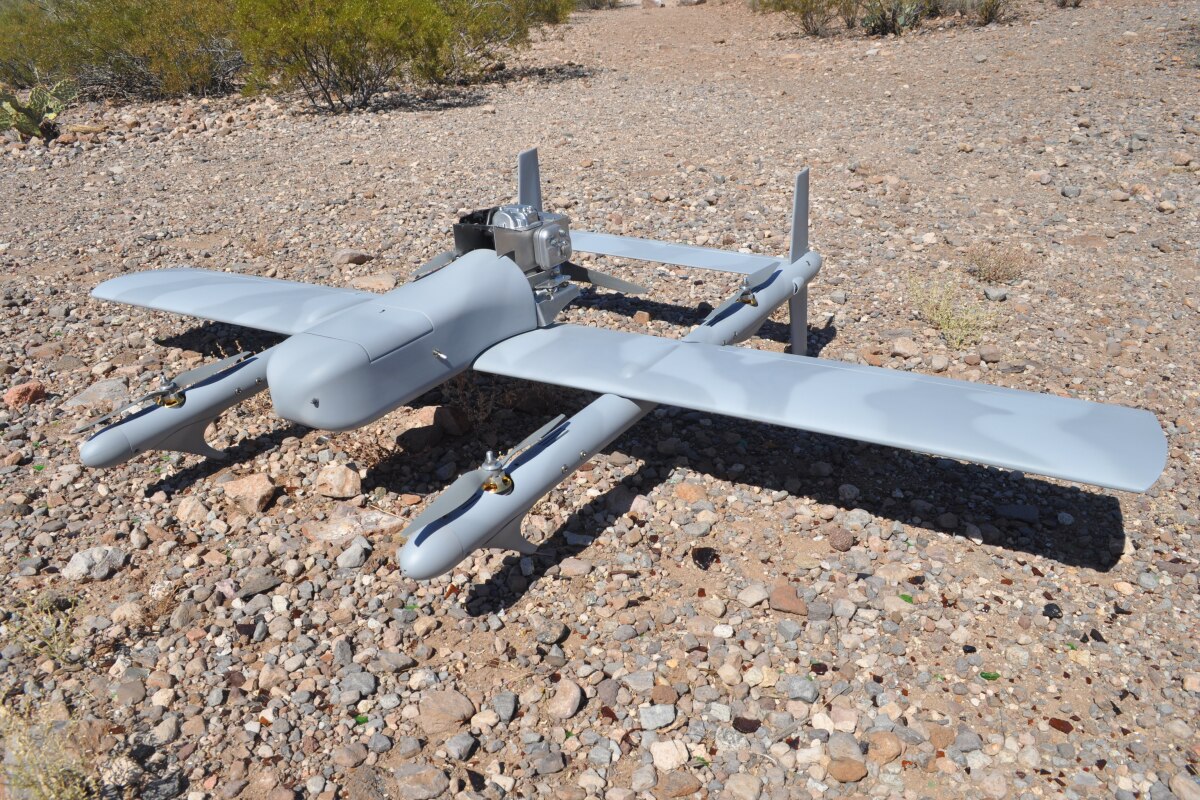If you need a drone aircraft that can hover in one spot or perform vertical take-offs and landings (VTOL), then a multi-rotor contraption such as a quadcopter is the way to go. Should you be looking for something that can cover long distances as quickly and efficiently as possible, however, then a more traditional propellor-driven fixed-wing airplane will serve you better. So, what if you want both? Well, that’s where Latitude Engineering’s Hybrid Quadrotor UAV (unmanned aerial vehicle) comes in. Putting it simply, it’s a quadcopter/fixed-wing combo.
For take-offs, landings and hovering, the HQ utilizes four horizontally-mounted propellors – just like a regular quadcopter. These are each driven by an individual electric motor, all four of which receive their power from two 5-cell 11,000 milliamp-hour lithium-polymer battery packs.
Once the HQ reaches cruising altitude, however, its vertically-mounted push prop takes over. Powered by a 0.5-hp 4-stroke gas engine, it takes the aircraft to a forward cruising speed of around 40 knots (46 mph, or 74 km/h), which it can maintain for up to 15 hours.

The UAV is controlled either by a ground-based human operator, or via its own autonomous control system. “The Piccolo autopilot allows the use of a few different forms of control, ranging from complete manual where it flies exactly like an RC plane/quadrotor to complete auto including take-off, landing and waypoint tracking,” lead engineer Carlos Murphy tells us. “We have successfully flown complete autonomous flights which include autonomous take-off, transition to forward flight, then transition back to hover and landing.”
There are actually two versions of the HQ currently in development. The latest incarnation of the first model (described above) has a composite airframe made largely of carbon fiber-skinned foam and balsa wood, along with ABS plastic. It weighs in at 25 lb (11.3 kg), and can carry a payload of up to 2 lb (0.9 kg).
More recently, work has begun on a larger, pure carbon fiber-bodied HQ. It weighs 60 lb (27.2 kg), carries 8 lb (3.6 kg), and has a 5-hp engine that should hopefully keep it aloft for up to 24 hours. Additionally, along with the four lifting propellors on the top surface of its airframe, it has an additional four located on the underside – this makes it an “octocopter,” so to speak.

This larger model is being developed under a contract with the US Navy and is scheduled for delivery within the next month, for subsequent field tests. It is expected to sell for around US$60,000, with the 25-lb version coming in somewhere around $25,000 to $30,000.
Finally, some readers may be wondering why Latitude didn’t just go with a tilt-rotor design. According to Murphy, there were three main reasons: the HQ design is simpler, requiring fewer moving parts and thus offering increased reliability; any small weight penalties of the design are offset by its advantages; and, its dual gas/electric propulsion system allows the UAV to stay in the air longer.
This last point is due to the fact that while the high power output of the electric motors is used to get the HQ airborne, gasoline’s superior energy density (as compared to that of batteries) comes into play once the aircraft starts traveling forward. “When you make a tilt-rotor all electric powered, you need tons of batteries if you want endurance,” Carlos explains. “If you want a high-endurance gas tilt-rotor you need (for the sake of argument) a super-charged V8 to take off, while during forward flight all you need is a tiny little inline 4 ... vertical take-off and forward flight have pretty much mutually exclusive requirements when it comes to power sources.”
With the HQ, he says, “you are always flying with the correct power source for the job, VTOL or conventional flight.”
Source: Latitude Engineering via Popular Science












